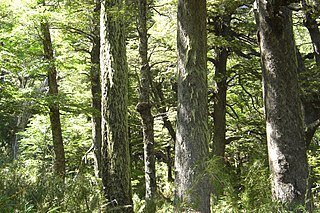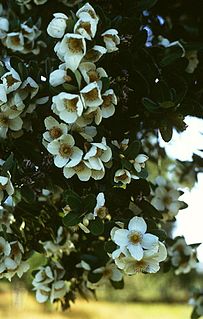 W
WThe Valdivian temperate forests (NT0404) is an ecoregion on the west coast of southern South America, in Chile and extending into Argentina. It is part of the Neotropical realm. The forests are named after the city of Valdivia. The Valdivian temperate rainforests are characterized by their dense understories of bamboos, ferns, and for being mostly dominated by evergreen angiosperm trees with some deciduous specimens, though conifer trees are also common.
 W
WAextoxicon punctatum, the sole species of genus Aextoxicon and family Aextoxicaceae, is a tree native to southern Chile and Argentina. Commonly known as the olivillo or aceitunillo, it is a large evergreen tree native to the forests of the Valdivian temperate rain forests and Magellanic subpolar forests of southern Chile's Pacific coast, where it forms is a canopy tree in the broadleaf forests. It can reach 15 m tall.
 W
WAextoxicon punctatum, the sole species of genus Aextoxicon and family Aextoxicaceae, is a tree native to southern Chile and Argentina. Commonly known as the olivillo or aceitunillo, it is a large evergreen tree native to the forests of the Valdivian temperate rain forests and Magellanic subpolar forests of southern Chile's Pacific coast, where it forms is a canopy tree in the broadleaf forests. It can reach 15 m tall.
 W
WAlerce Andino National Park is located in the Andes, in Los Lagos Region of Chile. This national park covers about 393 km². It is bounded by the Reloncaví Estuary on its east and south sides, and by the Reloncaví Sound to the west. To its north lies Chapo Lake.
 W
WAustrocedrus is a genus of conifer belonging to the cypress family (Cupressaceae). It has only one species, Austrocedrus chilensis, native to the Valdivian temperate rain forests and the adjacent drier steppe-forests of central-southern Chile and western Argentina from 33°S to 44°S latitude. It is known in its native area as ciprés de la cordillera or cordilleran cypress, and elsewhere by the scientific name as Austrocedrus, or sometimes as Chilean incense-cedar or Chilean cedar. The generic name means "southern cedar".
 W
WAustrocedrus is a genus of conifer belonging to the cypress family (Cupressaceae). It has only one species, Austrocedrus chilensis, native to the Valdivian temperate rain forests and the adjacent drier steppe-forests of central-southern Chile and western Argentina from 33°S to 44°S latitude. It is known in its native area as ciprés de la cordillera or cordilleran cypress, and elsewhere by the scientific name as Austrocedrus, or sometimes as Chilean incense-cedar or Chilean cedar. The generic name means "southern cedar".
 W
WThe Bosque Andino Patagónico is a type of temperate to cold forest located in southern Chile and western Patagonia in Argentina at the southern end of South America. The climate here is influenced by humid air masses moving in from the Pacific Ocean which lose most of their moisture as they rise over the Andes. The flora is dominated by trees, usually of the genus Nothofagus.
 W
WThe Cordillera de Oncol is a mountain range, located along the Pacific coast in southern Chile. It is part of the Chilean Coast Range System. It was named for the city of Valdivia. The highest point of the range is Cerro Oncol, at 715 m.
 W
WEucryphia cordifolia, the ulmo, is a species of tree in the family Cunoniaceae. It is found in Chile and Argentina. It is threatened by logging and habitat loss. The natural habitat is along the Andes Range from 38 to 43°S, and up to 700 meters (2300 ft) above sea level. It is a very elegant tree with a thick trunk and wide crown and can become over 12 m (40 ft) high. It blooms in February and March, depending on latitude and altitude. The fruit is a capsule about 1.5 cm (0.6 in) length.
 W
WHornopirén National Park is located in the Andes, in the Palena Province of Chile's Los Lagos Region, also known as Region X. The park contains 482 km2 (186 sq mi) of rugged mountains and unspoiled Valdivian temperate rain forests. This national park borders the northern portion of Pumalín Park. The Carretera Austral passes close to the park. In the vicinity of the park lie Hornopirén and Yate volcanoes.
 W
WLas Vertientes Private Nature Reserve is a Private Nature Reserve of Chile located in the Los Lagos Region, of Patagonia in southern Chile. Created in 2009 as a private nature reserve operated by the Corporación Nacional Forestal, it protects the plants and animals of the Valdivian temperate rainforest located here. The 100 square kilometres (39 sq mi) reserve's emphasis is on restoration of the temperate rainforest ecosystem, rather than providing a public amenity. The park is opened to a small number of people as it tries to encourage the return of endangered fauna and flora. It's the only private protected area in Los Muermos.
 W
WLaureliopsis is a genus of flowering plants with just one species, Laureliopsis philippiana, known as tepa, endemic to Chile and Argentina. In Chile it is found from Maule to Aysen. It grows on humid and deep soils.
 W
WLaureliopsis is a genus of flowering plants with just one species, Laureliopsis philippiana, known as tepa, endemic to Chile and Argentina. In Chile it is found from Maule to Aysen. It grows on humid and deep soils.
 W
WLlanquihue National Reserve is a national reserve of Chile.The reserve is bordered by the Petrohué River on the northeast and by the Reloncaví Estuary on the east. To the south, Chapo Lake and its shoreline is an intermediate area between the reserve and Alerce Andino National Park.
 W
WNothofagus dombeyi, Dombey's beech, coigue, coihue or coigüe is a tree species native to southern Chile and the Andean parts of Argentine Patagonia. It is a fast-growing species that can live in a wide range of climatic conditions, and forms dense forests. It is cultivated for its timber, and as an ornamental subject.
 W
WThe Bosque Andino Patagónico is a type of temperate to cold forest located in southern Chile and western Patagonia in Argentina at the southern end of South America. The climate here is influenced by humid air masses moving in from the Pacific Ocean which lose most of their moisture as they rise over the Andes. The flora is dominated by trees, usually of the genus Nothofagus.
 W
WPilgerodendron is a genus of conifer belonging to the cypress family Cupressaceae. It has only one species, Pilgerodendron uviferum, which is endemic to the Valdivian temperate rain forests and Magellanic subpolar forests of southern Chile and southwestern Argentina. It grows from 40 to 55°S in Tierra del Fuego, where it is the southernmost conifer in the world. It is a member of subfamily Callitroideae, a group of distinct Southern Hemisphere genera associated with the Antarctic flora.
 W
WPilgerodendron is a genus of conifer belonging to the cypress family Cupressaceae. It has only one species, Pilgerodendron uviferum, which is endemic to the Valdivian temperate rain forests and Magellanic subpolar forests of southern Chile and southwestern Argentina. It grows from 40 to 55°S in Tierra del Fuego, where it is the southernmost conifer in the world. It is a member of subfamily Callitroideae, a group of distinct Southern Hemisphere genera associated with the Antarctic flora.
 W
WPuyehue National Park is located in the Andes mountain range, in Los Ríos and Los Lagos regions of Chile formerly referred to as the 10th region. The park boast 220,000 acres of natural thermal springs, volcanoes, and evergreen forests, after having been expanded in 1950 and 1981. The park is Chile's most visited national park with 400,000 people enjoying it each year. Puyehue National park forms part of the Reserve of Temperate Rainy Forest Biospheres of the Southern Andes. Chile Route 215 passes through the park, which connects with the Argentine Route 231 via Cardenal Antonio Samoré Pass.
 W
WSaxegothaea is a genus comprising a single species, Saxegothaea conspicua. It is a conifer in the podocarp family Podocarpaceae, native to southern South America. It grows in Chile and Argentina from 35° to 46° South latitude; in its northernmost natural distribution it grows between 800 and 1000 (2600–3300 ft) m above sea level and in the south it lives at sea level. The species is most often known by its genus name, or sometimes as female maniu and Prince Albert's yew; in South America it is known as mañío hembra or maniú hembra.
 W
WSaxegothaea is a genus comprising a single species, Saxegothaea conspicua. It is a conifer in the podocarp family Podocarpaceae, native to southern South America. It grows in Chile and Argentina from 35° to 46° South latitude; in its northernmost natural distribution it grows between 800 and 1000 (2600–3300 ft) m above sea level and in the south it lives at sea level. The species is most often known by its genus name, or sometimes as female maniu and Prince Albert's yew; in South America it is known as mañío hembra or maniú hembra.
 W
WValdivia National Reserve is a federal nature reserve in the coastal mountain area of Los Ríos Region, in Chile.
 W
WThe Cordillera de Oncol is a mountain range, located along the Pacific coast in southern Chile. It is part of the Chilean Coast Range System. It was named for the city of Valdivia. The highest point of the range is Cerro Oncol, at 715 m.
 W
WValdivian Coastal Reserve is a natural reserve located in the Cordillera Pelada, in Los Ríos Region of Chile, near Corral.
 W
WVicente Pérez Rosales National Park is located in Los Lagos Region, Llanquihue Province, of Chile. Its western entrance is close to the Ensenada locality, 82 km (51 mi) northeast of the provincial capital of Puerto Montt, and 64 km (40 mi) from Puerto Varas along Ruta CH-225. This national park covers about 2,530 km2 (977 sq mi) and is almost entirely in the Andes mountain chain. The adjacent national parks Vicente Pérez Rosales and Puyehue National Park in Chile, and Nahuel Huapi National Park and Lanín National Park in Argentina, provide a continuous protected area of close to 15,000 km2 (5,792 sq mi).
 W
WVillarrica National Park is located in the Andes, in the La Araucanía and Los Ríos regions of Chile, near Pucón. The centerpiece of the park is a line of three volcanoes stretching transversely to the Andean range: Villarrica, Quetrupillán, and Lanín. Other mountains in the park include Quinquilil volcano, also known as Colmillo del Diablo, and Cerro Las Peinetas, which lies on the border between Argentina and Chile. It ranges in elevation from 600 m (1,969 ft) to 3,776 m (12,388 ft) at Lanín Volcano.
 W
WWeinmannia trichosperma, the tineo, is an evergreen tree in the family of Cunoniaceae, it is native to Chile and Argentina: 35 to 47°S. endemic to laurel forest habitat.